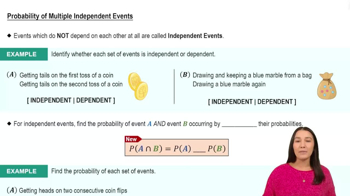Here are the essential concepts you must grasp in order to answer the question correctly.
Probability of Events
Probability is a measure of the likelihood that an event will occur, expressed as a number between 0 and 1. In this context, P(A) and P(B) represent the probabilities of events A and B occurring, respectively. Understanding how to interpret these probabilities is essential for analyzing the relationship between the events.
Recommended video:
Probability of Multiple Independent Events
Union of Events
The union of two events, denoted as P(A or B), represents the probability that at least one of the events occurs. To calculate this, we typically use the formula P(A or B) = P(A) + P(B) - P(A and B). However, without knowing P(A and B), we cannot determine P(A or B) accurately.
Recommended video:
Probability of Multiple Independent Events
Independence of Events
Events A and B are independent if the occurrence of one does not affect the probability of the other. If A and B are independent, we can calculate P(A and B) as P(A) * P(B). However, the question does not provide information about their independence, which is crucial for determining P(A or B) without additional data.
Recommended video:
Probability of Multiple Independent Events
 Verified step by step guidance
Verified step by step guidance Verified video answer for a similar problem:
Verified video answer for a similar problem:



 5:14m
5:14m